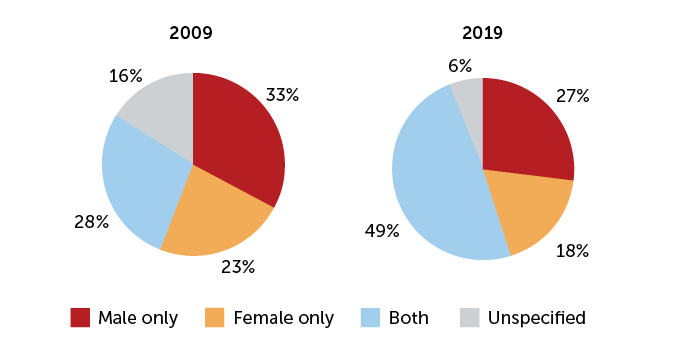I don’t doubt that women are underrepresented in medical research, but at the same time I suspect most medical research targets issues that affect both men and women, since that is true of most medical issues. The 7% statistic would be more impactful if we could compare it to the percentage of medical research focused on medical issues specific to men.
Edit: after further consideration, my initial take here isn’t great either, because women face more medical issues specific to their gender. I still think the 7% statistic is a little misleading.
Yep, that 7% doesn’t mean the rest is going to research on men specific health, it means that 7% is for women health, an unknown % is for men health and the rest is for human health in general (which is logically the biggest %).
Issues that affect both women and men still often tend to affect both in different ways – but the majority of medical research tends to just take what works for the standard male body and apply that to everyone regardless of sex instead of investigating sex-specific effects and tailoring solutions around that
deleted by creator
I’m making this claim from an American standpoint: A famous example is that fewer girls and women are diagnosed with autism, and those that have been are either profoundly autistic or have had to educate their doctors. Girls are usually socialized differently than boys, so some of the criteria for autism just aren’t a good fit
that’s a clinical bias, the person above was asking about a research bias.
edit:
https://www.sciencenews.org/article/biomedical-research-sex-male-female-animal-human-studies
as of 2019:
Behavioral research was the most inclusive, with both sexes in 81 percent of studies.
I want to know where you think clinical criteria come from
Edit: your article describes a study that found research to be dominated by male biology when it was published 2011. This article found a nine year average delay in updating clinical guidelines. People who were in university to be a doctor within the last ten years are likely still operating on older research, unless they have taken the time to stay up to date.
I have a year left on my BS in Biology. There is so much new research coming out that I read, that I know my classmates don’t have the time for. So what we are taught from textbooks is what they learn, and this is a large part of where they get their biases from
clinical bias is not necessarily from the criteria. often the clinician is the one introducing the bias all on their own.
deleted by creator
deleted by creator
“In 2020, only 1% of funding for healthcare research and innovation (beyond oncology) was invested in women’s health.”
That 7% is doing an awful lot of heavy lifting. You don’t even need specific numbers to see how wacky the logic is: who here really believes that 93% of gynecological research is conducted on men? Research into ovarian cancer? Development into drugs for preeclampsia?
If you were I’m going with this… yes, women are massively under represented in medical research that applies to both men and women, and there are problems with that too, such as major differences between cardiovascular issues in men and women. Most people, including doctors and nurses, would not recognize the symptoms of a heart attack in a woman unless they were specifically looking for them.
93% of gynecological research is conducted on men? Research into ovarian cancer? Development into drugs for preeclampsia?
That’s not what that means at all. It means gynecological research + research into other issues that only affect female physiology only accounts of 7% of all medical research. The other 93% is either focused on general or male-specific issues (and conducted mostly on men).
Is it just medical research? It just says research in general. I’m not making a claim either way, but agree it’s worded very poorly.
Yes, I know what it means. That’s why the headline is bit misleading.
The headline is of course misleading, but not really for the reasons you pointed out. Nobody is going to read that headline and think it means 93% of gynecological research is conducted on men. Some people might read it and think it means 93% of medical research overall is conducted on men, though.
I won’t pretend to see the whole picture here but it sounds like we’re talking about 7% female specific data vs everything else. Most of the remaining data may be non gender specific.
To present this as 7% female and 93% male is disingenuous.
As a counterpoint, breast cancer research (an issue predominantly affecting women) recieves far more funding than prostate cancer research.
Then again, is breast cancer here counted as female or non gender specific?
They really do make it sound as if 93% goes to male only research, but I highly doubt that’s he case
I’m a casual observer, so take this as the understanding of some dumbass on lemmy rather than anybody who’s actually been in the medical field. My understanding is that the majority of “non-gendered” medical research done through history has actually been male only, given discrimination and women being hidden inside the home for a lot of history. I’ve also heard that young male cadavers were WAY more available in like industrial revolution england than young female cadavers (affecting both medical research and training) just given who was more likely to get a dangerous job and die young. I know modern medicine understands how to sample a population a bit better than that, but the absolute vast majority of medical research still happened in places/eras that considered women property.
There is no such thing as “non gender specific”. That’s a lie you’ve been sold. “Gender neutral”’ means cismale.
Hormones play a huge part in drug interactions and cis men do not cycle like ciswomen.
Look up gender differentiated responsiveness to “non-gendered” SSRI dosages for example.
As a researcher who works in biomedical sciences, a large part of that is lack of women volunteers or consent.
We can’t simply force trials onto women, we have to get consent.
How would you suggest we get women to volunteer for early trials?
I promise we’d love to have a perfect sample set, and gender differences are extremely important (Another study we’re debating doing is with the lethality of a gene knockout in male mice only, but not female mice, which we found incidentally while doing something else)
the standard baseline is almost always a typical male body
luckily this is not really true anymore.
https://www.sciencenews.org/article/biomedical-research-sex-male-female-animal-human-studies

If you read the linked source, it says 7% is research that is aimed at issues that EXCLUSIVELY affect women.
Yep so people need to understand that it doesn’t mean that 93% goes to men specific issues.
incredibly misleading. piss off with your bullshit
Not true. Most studies nowadays include male & female participants - and more research focuses on exclusively female than exclusively male issues
The real bias is against normal human beings. Nursing/medical students and medical professionals are vastly overrepresented amongst study participants - and young people. These groups of people are much healthier than the average human being. Steps have been taken to address this too, but it is slow going.
That sounds fine. How much funding should go to exclusively womens issues?
How much funding is on male only health issues? We need something to compare because that stat alone is useless.
It honestly strikes me as high.
I would expect that women-exclusive or male-exclusive issues would be less than 7% of all issues.
Buddy, you have no idea how many medical issues happen doing to pregnancy and child birth alone. It’s staggering.
Enlighten us then, how many issue happen between pregnancy and child birth?
I understand it’s a lot. I’d be willing to bet women-exclusive issues dwarf men-exclusive issues for the reason you said.
But still, if you were to catalogue every medical condition known to exist, that women exclusive conditions exceed 7% of the total?
I’m worried that people think I’m diminishing the number of things that can go haywire in pregnancy, I’m not. I’m saying that you’re underestimating the TOTAL number of things that can go haywire in the entire human body.
deleted by creator
Couldn’t open the source link, unfortunately. So what’s the percentage of women specific health issues? And what % of funding goes to health issues that only impact men?
more than likely medical professionals are more likely to ignore women, when they present symptoms of a disease, they are often balked, or dismissed as attention seeking behaviour. heart disease tends to be ignored in women in some cases.
medical science is less clear on biasing against woman or men. they might focus on certain gender groups for different diseases, like MS is more likely to occur in women, but in men its more severe. some cancers are more likely in men than woman. like P.Dermatitis is more common in women than in men, but some diseases are equally affecting both genders.
also for cancers, they might ignore both genders if you’re “too young” for it.
deleted by creator
I think medical research is also biased against healthier people. The “standard baseline… male body” isn’t particularly healthy, especially in older ages. People just don’t take very good care of themselves, they eat crappy food, and don’t exercise. I’m thinking specifically of high LDL cholesterol, and statins being universally shoved at us to bring it down. But, recent research shows that high LDL cholesterol alone, in an otherwise quite healthy person, may not be the risk to plaque build up it’s assumed to be. Because, most of the research is done on less healthy, “standard baseline… males.”
That’s wild considering most men never go to the doctors willingly
Yes, but consider that there was likely a financial incentive to be part of the trials.
As many have pointed out, this did not mean 93% is focused on men, it means that 7% is exclusively about women’s health. I strongly suspect the vast majority is not gender specific (men’s issues I would hope are smaller than 7% by a wide margin, since there’s not much that goes too wrong that is inherent to men’s physiology and much of it is more cosmetic in nature, while women specific health issues tend to be more dire.
So, to make up a number, it could be that 90% is generic across general human biology. So that the results could be applied to everyone so they catch the women going to the doctor as well as the men, if your assumption were true
This coming from x? Yeah I’m not trusting shit that comes from that fuckhole of a website. Not a stat nor one of its retarded users
Edit: my bad broskis, I’m just feeling a lil aggressive this morning and I am not sure why
Is this even a childfree topic? I’m blocking this community.
It’s certainly an argument for not having them. In the US, women in Texas are dying of sepsis because they can’t abort non-viable fetuses. Health care for women in some places is terrible. I think it was Nigeria where a huge percentage of women die in childbirth.
I think a lot of people are missing the point here. The thought “but how much research is dedicated to just men?” isn’t a salient retort.
Women are 50% of the population, and 100% of the humans alive today grew inside body systems that are exclusive to that population. Why would only 7% of research being about women be ok with that reality?
One great source for the gender gap in science is the book Invisible Women. It shows the dire need for data that studies women specifically, as well as having gender-aggregated data in research that studies both sexes. The current body of science, which is based on hundreds of years of research, mostly studied only men or studied both sexes and didn’t separate the results by sex, so women are mostly invisible in research.





